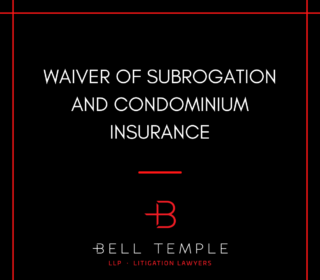When proceeding to the document discovery stage of a lawsuit, parties have a duty to disclose all relevant documents in their possession, control or power. They do so through an Affidavit of Documents, which lists and describes all documents relevant to any matter in the action.
These documents are split into three separate schedules under Rule 30.03(2):
1) Schedule A documents are those that are in the party’s possession, control or power that they do not object to producing;
2) Schedule B documents are those that are in the party’s possession, control or power that they object to producing on the grounds of privilege; and
3) Schedule C documents are those that were formerly in the party’s possession control or power that are no longer in their possession.
For matters proceeding under Rule 76 – Simplified Procedure, a Schedule D is required listing the names and addresses of persons who might reasonably be expected to have knowledge of transactions or occurrences in issue (Rule 76.03(2)).
The contents of a Schedule B and C are heavily litigated in the Canadian Courts, as parties are constantly seeking to unveil documents from opposing parties that would assist in their litigation strategy.
Schedule A documents, on the other hand, are rarely litigated. The uncontested nature of Schedule A documentation has led to a culture of complacency on those drafting Affidavit of Documents.
As lawyers attempt to find cost efficient solutions for their clients, they commonly take shortcuts at the document discovery stage. This leads to Schedule A’s containing unorganized documents, mass grouping of documents under a single name, and documents without ample description.
Lawyers should be wary of the potential drawbacks of complacency in the document discovery process, and this blog will explore how not producing an adequate Schedule A can result in high costs to a lawyer’s clients.
Improper Grouping of Documents
The leading authority in determining the adequacy of an Affidavit of Documents is Solid Waste Reclamation Inc. vs. Philip Enterprises Inc., 1991 CanLII 7369 (ON SC). The cited case in this action was for an application made by the Defendant requesting a further and better Affidavit of Documents from the Plaintiff.
The Plaintiff had provided the Defendants with a Schedule A that included 638 descriptions of both individual documents and groups of documents, all of which were under various headings.
The court did not describe every heading, but selected a few that served as examples. These headings did not contain any helpful description of each document file, as they were a non-sensical string of titles including: “1Bundle photocopies Evaluation I. Waxman & Sons, estate Freeze and share transfer 49 10/00/87InvoicesPhilipI. Waxman From August 1987 Mill & SonsScale 53 00/00/88Bank Statements Windermere, CIBC, Queen-York, 1975-1988…”. Each line of the headings were numbered, and most of the entries contained a date. However, the Affidavit of Documents was overall a mess. There was inconsistent numbering, multiples entries for a single item, and it was overall impractical.
The Defendant argued that the Affidavit of Documents was inadequate, as each individual document had not been properly numbered. In making this argument, the Defendant posed a number of questions about the Schedule A to the court, like: how could the Defendant call for a specific document from a bundle at a trial or discovery, or how could the Defendant know that each document was a complete copy? The court found that, “In cases where groups of documents having to do with the same subject-matter or coming from the same source or having some other common denominator between them are voluminous they may be listed in groups with sufficient detail to enable the other party, upon reading the list, to understand generally what they contain, where they originated, when they originated and the number of pieces within the group” [1]. The Defendant was ultimately successful with their application, with the court holding that any further Affidavit of Documents must, at a minimum:
(1) enable swift and sure retrieval at trial or discovery;
(2) enable counsel examining the documents of another party to relate each document to its reference on Schedule A and to satisfy himself that all documents listed are actually in the collection he is examining;
(3) enable counsel at trial to ascertain swiftly that a document which is tendered tobecome an exhibit is in fact a document produced in Schedule A;(4) be compatible with computer retrieval systems; and
(5) be implemented before copies of the documents are made, so that the copies in the hands of all parties bear the identifier. [2] The court’s view with reference to bundles of documents and numbering was adopted in Seifert v. Finkle Electric Ltd., 2020 ONSC 394. In this action, the Defendant brought a motion against the Plaintiff for a further and better Affidavit of Documents. The Defendant argued that the Plaintiff’s Schedule A failed to individually list and identify each document produced, when they listed a large collection of documents under one item. The following list of document groupings were some of those contested by the Defendants:
a. Tab 1. Document Description – CIBC Disability or Job Loss claim forms. Date –
Various”;
b. Tab 2. Document Description – Client provided file to Bonn Law containing various records. Date – Various”;
c. Tab 14. Document Description – Karren Seifert’s Employment Insurance File. Date – January 1, 2014 to May 25, 2018;
d. Tab 36. Document Description – Income Tax Records. Date – 2012 to 2017; and
e. Tab 48. Document Description – Client Provided medical records. Date – January 16, 2015 to December 9, 2017.
The Defendant sought an order that the listing of files of documents under one item, should not be permitted.
The court granted the motion, specifically finding that the listing of files, collections of documents or bundles of documents under one item, even though page numbered, were not sufficient to be in compliance with Rule 30.03(2). The court additionally held that, “in addition to page numbering, the individual documents within the collection of documents or file must be sufficiently and properly identified to meet the requirements of Rule 30.03(2)” (underlining done by the court) [3]. The court distinctly placed a burden on the party serving the Affidavit of Documents to properly identify each document relied upon in litigation.
In keeping with the finding in Solid Waste, the court found that the Schedule A must allow the party to quickly access a document at discovery or trial, relate each document to its reference in Schedule A, and other characteristics relating to the organization and completeness of the Affidavit of Documents.
Insufficient Description
In Bluekey Education Ltd. et al. v. Jian Wang et al., 2022 ONSC 3450, a motion was brought by the Plaintiff to compel a further and better Affidavit of Documents from the Defendant. The Defendant had delivered an Affidavit of Documents to the Plaintiff that contained approximately 600 Schedule A documents. None of the documents were labeled with a unique number, nor did they have a description of what they contained. Instead, the productions were given non-descript titles such as “045X05.pdf” or “C128jpg”.
The court remarked that the requirements of rule 30.03(2) of the Rules of Civil Procedure are more than mere technicalities when requiring parties to “list and describe” documents. As the Defendant’s Schedule A had no unique production numbers, and no description, it was deemed impractical to deal with. The presiding judge described a scenario of a party at an examination for discovery. Should the party want to reference a particular document, it would be entirely impractical to say “refer to document C128jpg”.
Ultimately, the court required that the Defendant produce a further Affidavit of Documents that contained a number, a date, and a description for each document. Costs for the motion were made payable to the Plaintiff.
Improper descriptors were also explored in Thompson v. Arcadia Labs Inc. 2016 ONSC 3745. In this action, the Plaintiff brought a motion for a further and better Affidavit of Documents from the Defendants. The Defendants Schedule A provided a large volume of electronic documents, and the parties had failed to agree on a protocol for electronic indexing. They also disagreed as to how the vast number of documents could best be captured in the Affidavit of Documents.
When dealing with a significant amount of electronically stored information, it was deemed ‘virtually impossible’ to list and describe all relevant documents. For this reason, the court expected the parties to engage in a collaborative discovery plan. The court found that parties should comply with the purpose and objective of document discovery, as opposed to formal or technical compliance.
The court notes that the party producing the documents have an obligation to index the documents and identify the ones that are relevant. This party is not allowed to unilaterally shift the burden of locating and identifying documents to the opposing party.
As an order, the court found that the Defendants were obliged to produce an index for documents contained within subfolders and multiple files. The court noted that the documents did not have to be indexed and described in the affidavits of documents, but only if the parties agree, or if the court determines another method of indexing, identifying and retrieving the documents is more useful.
Takeaways
It is important for lawyers to consider the potential drawbacks of producing an improperly organized Affidavit of Documents. The requirement for parties to “list and describe” all relevant documentation requires a degree of care. The Plaintiff’s Schedule A must be sufficiently and properly identified to be compliant with Rule 30.03(2) of the Rules of Civil Procedure. What this entails will depend on each specific case, but the case law above provides some general characteristics of a Schedule A that will be necessary. This includes a proper numbering system, where each document is assigned a unique number. This also may include a description of the document that goes beyond a vague name like “04X04.pdf”.
The burden of the Rule is placed solely on the party producing documentation, and they must take responsibility to ensure that their in compliance. If they try to cut corners in the creation of the Affidavit of Documents, they could be subject to a motion for a further and better Affidavit of Documents. If the opposition is successful, it would lead to even more costs against their client.
Finally, it’s important to discuss with opposing counsel to determine an agreeable discovery plan for all parties. Parties can step away from the traditional Schedule A, Schedule B format, so long as they agree (or the court deems it) that an alternative method is more useful.







